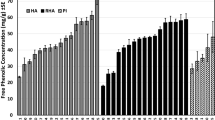Abstract
Seven antifeedant sesquiterpene lactones (STLs), 4,5-dihydroniveusin A, argophyllin B, argophyllin A, 15-hydroxy-3-dehydrodesoxytifruticin, niveusin B, 1,2-anhydridoniveusin A, and an unidentified epoxide, in cultivated sunflower (Helianthus annuus L.) have been quantified by a highperformance thin-layer chromatography and UV-reflectance scanning densitometry analysis. Age-related expression of STL content in sunflower reveals a heretofore undescribed pattern in which nonpolar STLs such as 15-hydroxy-3-dehydrodesoxytifruticin predominate up to an age of three weeks, but are subsequently displaced by polar STLs, especially argophyllin A, through later foliar stages and anthesis. This leaf pattern of STL ontogeny is maintained in three widely differentH. annuus cultivars (Giant Gray Stripe, Royal Hybrid 2141, Hybrid 7111), which in turn had similar total contents of STLs. Antifeedant activity for western corn rootworm was positively correlated with STL content, particularly with argophyllin A and its isomer argophyllin B, in respective tissue extracts. Enhanced amounts of highly antifeedant argophyllins, especially in newly grown leaf and floral tissues yielding sunflower progeny, strongly suggest that these epoxy-STLs are a chemical defense against insect herbivory.
Similar content being viewed by others
References
Chou, J.-C. 1992. Phenologic and tissue distribution in cultivated sunflower of antifeedant sesquiterpene lactones for western corn rootworm. MS thesis. Pennsylvania State University, University Park, Pennsylvania.
Chou, J.-C., andMullin, C.A. 1993. Phenologic and tissue distribution of sesquiterpene lactones in cultivated sunflower (Helianthus annuus L.).J. Plant Physiol. Accepted.
Duke, S.O. 1991. Plant terpenoids as pesticides, pp. 269–296,in R.F. Keeler and A.T. Tu (eds.). Handbook of Natural Toxins: Toxicology of Plant and Fungal Compounds, Vol. 6. Marcel Dekker, New York.
Gershenzon, J., andCroteau, R. 1991. Terpenoids, pp. 165–219,in G.A. Rosenthal, and M.R. Berenbaum (eds.). Herbivores: Their Interaction with Secondary Plant Metabolites, 2nd ed., Vol. I. The Chemical Participants. Academic Press, New York.
Gershenzon, J., Mabry, T.J., Korp, J.D., andBernal, I. 1984. Germacranolides fromHelianthus californicus.Phytochemistry 23:2561–2571.
Isman, M.B., Brard, N.L., Nawrot, J., andHarmatha, J. 1989. Antifeedant and growth inhibitory effects of bakkenolide-A and other sesquiterpene lactones on the variegated cutworm,Peridroma saucia Hubner (Lep.; Noctuidae).J. Appl. Entomol. 107:524–529.
Mabry, T.J., andGill, J.E. 1979. Sesquiterpene lactones and other terpenoids, pp. 501–537,in G.A. Rosenthal, and D.H. Janzen (eds.). Herbivores: Their Interaction with Secondary Plant Metabolites. Academic Press, New York.
Melek, F.R., Gage, D.A., Gershenzon, J., andMabry, T.J. 1985. Sesquiterpene lactone and diterpene constituents ofHelianthus annuus.Phytochemistry 24:1537–1539.
Mullin, C.A., Alfatafta, A.A., Harman, J.L., Everett, S.L., andSerino, A.A. 1991a. Feeding and toxic effects of floral sesquiterpene lactones, diterpenes and phenolics from sunflower (Helianthus annuus L.) on western corn rootworm.J. Agric. Food Chem. 39:2293–2299.
Mullin, C.A., Alfatafta, A.A., Harman, J.L., Serino, A.A., andEverett, S.L. 1991b. Com rootworm feeding on sunflower and other Compositae: Influence of floral terpenoid and phenolic factors, pp. 278–292,in P.A. Hedin (ed.). Naturally Occurring Pest Bioregulators. ACS Symposium Series No. 449. American Chemical Society, Washington, D.C.
Ohno, N., andMabry, T.J. 1980. Sesquiterpene lactones and diterpene carboxylic acids inHelianthus niveus subspeciescanescens.Phytochemistry 19:609–614.
Picman, A.K. 1986. Biological activities of sesquiterpene lactones.Biochem. Syst. Ecol. 14:255–281.
Picman, A.K., Ranieri, R.L., Towers, G.H.N., andLam, J. 1980. Visualization reagents for sesquiterpene lactones and polyacetylenes on thin-layer chromatograms.J. Chromatogr. 189:187–198.
Proksch, P., Wray, V., Isman, M.B., andRahaus, I. 1990. Ontogenetic variation of biologically active natural products inAgeratina adenophora.Phytochemistry 29:453–457.
Rees, S.B., andHarborne, J.B. 1985. The role of sesquiterpene lactones and phenolics in the chemical defence of the chicory plant.Phytochemistry 24:2225–2231.
Rogers, C.E., Gershenzon, J., Ohno, N., Mabry, T.J., Stipanovic, R.D., andKreitner, G.L. 1987. Terpenes of wild sunflowers (Helianthus): An effective mechanism against seed predation by larvae of the sunflower moth,Homoeosoma electellum (Lepidoptera: Pyralidae).Environ. Entomol. 16:586–592.
Rossiter, M., Gershenzon, J., andMabry, T.J. 1986. Behavioral and growth responses of specialist herbivore,Homoeosoma electellum, to major terpenoid of its host,Helianthus spp.J. Chem. Ecol. 12:1505–1521.
SAS/STAT User's Guide 1990. The ANOVA procedure, pp. 209–244,in ANOVA-FREQ. Version 6, 4th ed., Vol. 1. SAS Institute Inc., Cary, North Carolina.
Seaman, F.C. 1982. Sesquiterpene lactones as taxonomic characters in the Asteraceae.Bot. Rev. 48:121–592.
Spring, O. 1989. Microsampling: An alternative approach using sesquiterpene lactones for systematics.Biochem. Syst. Ecol. 17:509–517.
Spring, O., Kupka, J., Maier, B., andHager, A. 1982. Biological activities of sesquiterpene lactones fromHelianthus annuus: Antimicrobial and cytotoxic properties; influence on DNA, RNA, and protein synthesis.Z. Naturforsch. 37c:1087–1091.
Spring, O., Priester, T., Stransky, H., andHager, A. 1985. Sesquiterpene lactones in sunflower seedlings: Distribution in the plant and occurrence in genetic varieties as determined by an isocratic HPLC technique.J. Plant Physiol. 120:321–329.
Spring, O., Benz, T., andIlg, M. 1989. Sesquiterpene lactones of the capitate glandular trichomes ofHelianthus annuus.Phytochemistry 28:745–749.
Watanabe, K., Ohno, N., Yoshioka, H., Gershenzon, J., andMabry, T.J. 1982. Sesquiterpene lactones and diterpenoids fromHelianthus argophyllus.Phytochemistry 21:709–713.
Wisdom, C.S., andRodriguez, E. 1983. Seasonal age-specific measurements of the sesquiterpene lactones and chromenes ofEncelia farinosa.Biochem. Syst. Ecol. 11:345–352.
Author information
Authors and Affiliations
Rights and permissions
About this article
Cite this article
Chou, JC., Mullin, C.A. Distribution and antifeedant associations of sesquiterpene lactones in cultivated sunflower (Helianthus annuus L.) on western corn rootworm (Diabrotica virgifera virgifera LeConte). J Chem Ecol 19, 1439–1452 (1993). https://doi.org/10.1007/BF00984888
Received:
Accepted:
Issue Date:
DOI: https://doi.org/10.1007/BF00984888




